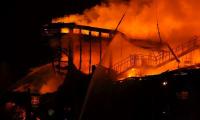What does it take to win a $23 billion-a-year war? With the DoD on the brink of recommitting up to 3,900 more US soldiers to the Afghan battlefield and a possible surge of private contractors to match, these developments do precious little to gloss over the obvious absence of an Afghan strategy.
Meanwhile, against the backdrop of a widening Pak-US trust deficit and tightening screws on US aid, the verdict of the state department’s inter-agency US policy review on Pakistan may well confirm what Islamabad has feared for a while: that anti-Pakistan sentiments in the US have hardened into a permanent Congressional trend line and nobody knows what to do with Afghanistan.
Beyond the math of reworked troop numbers, two questions still need answering. First, while Pakistan continues to be labelled the world’s favourite whipping boy on Afghanistan, do policymakers have what it takes to negotiate the real and rather obvious limits to Islamabad’s agency in the endgame with what is being asked of it? Policy voices in Kabul and the West remain strategically ambivalent about the hard choices that need to be made vis-à-vis an Afghan political settlement. And there is little international appreciation for the fact that the insurgency is strong and Kabul is weak for reasons that are mostly intrinsic to Afghanistan.
Second, as a divided government in Kabul struggles to overcompensate for its failings as a credible post-Westphalia project, what is the National Unity Government doing to prevent frustration and anger from becoming a boilerplate policy engine and a return to the 1990s-style warlordism? For a process that was meant to be Afghan-owned and led, the dearth of both leadership and ownership has never been quite this obvious.
As one would expect, there are no easy answers. Seventeen-year-old wars rarely come with instruction manuals and this month President Donald Trump may well become the third president in two decades to sanction a troop surge in Afghanistan.
But even as Washington seeks to counterbalance mission creep by layering unrealistic expectations onto regional actors, including Pakistan while absolving itself of its own costly mistakes in the process, Kabul and its leadership have taken to the Karzai-era mouth-foaming at Pakistan to vent their frustrations. The approach is neither responsible nor sustainable and only projects Kabul’s own inability to reconcile with a bilateral disconnect of its own making.
The problem is that the West continues to treat Afghanistan like a classically sovereign, geographically bounded-Westphalian project when it suits its purposes, but remains conveniently oblivious to Kabul’s glaring inability to reconcile with both its geography and its neighbourhood when it doesn’t.
Unlike the 1990s, today all of the Taliban’s 30,000 estimated fighters are Afghan. The West has done a marvellous job of painting over the country’s decentralised and fractured tribal realities. Fuelled by ethnic fault lines, the Taliban today are an indisputable political fact that, at best, contest, and, at worst, holds half of all rural territory – including districts to Afghanistan’s extreme west and north.
This year, the Taliban continued to mount spectacular attacks far from Pakistan’s border, let it be said, in areas such as Kunduz and Balkh. The influence of extra-regional actors such as Iran over the southern Taliban continues to be an apologetic endnote in Washington’s ‘Blame-Pakistan’ playbook. While the road to Kabul or Kandahar may have once run through Islamabad, years of strategic disconnect and a disastrous Western muddle-through have rerouted agency. Today, America’s demand for a signal-free highway sounds rather absurd.
So where does this leave Pakistan? Even as the US looks to embed its strategic priorities in a re-hyphenated ‘Af-Pak’ war theatre as it refuses to see Pakistan as a workable partner, Islamabad also needs to urgently rework and update its diplomatic script. Under the influence of its newly-empowered generals, the US has chosen to distance itself from the Moscow process, which is the most robust regional framework assembled to broker a great power consensus on the Afghan question since the US unilaterally aborted the QCG process last May.
This logic-gap is counterproductive and Pakistan’s embassies in foreign capitals must signal as much. Similarly, as the US continues to measure the war in terms of blood and treasure and in relation to battlefield gains rather than political deliverables, Pakistan must not shy away from asking how a third-generation troop surge can support its own counter-insurgency gains on this side of the international border. Having suffered firsthand from the spillover of the Afghan war, Islamabad has a clear interest in seeing an increase in the frequency and potency of the SOF operations in eastern Afghanistan. Pakistan should also clearly signal that by delinking a prospective surge from even the remotest possibility of a political settlement, unavoidable consequences are unavoidable.
For Mattis and his generals, the debate should be less about going big or going home, but rather about going long. While a troop surge can be a rung of a strategy, it cannot be the strategy in and of itself. Profound change, sans realistic goalposts and robust DC-Kabul, DC-Islamabad and Kabul-Islamabad lines of communication, is likely to fizzle fast. A mini-surge needs clear TORs, but not necessarily a public timeline. Its aim should be to reinvigorate and not just pile onto the conventional army corps – which, in turn, can relieve pressure on elite units without absolving them of their battlefield agency. On Pakistan too, the US must recognise that unburdening Islamabad of Congressional diktat and the baggage of excessive outcome benchmarks can allow for a more pragmatic conversation that delineates multiple responsibilities – including Washington’s role – in the region.
A secondary contradiction that must be grappled with is the fact that a complete withdrawal of foreign forces remains a long-standing Taliban demand before the group engages in talks. If the upcoming troop surge is designed to be a deterrent, it must also avoid becoming a casus belli for a renewed Taliban call-to-arms. Capabilities, rather than numbers, will be critical in translating into kinetic gains. Indeed, the smaller the surge, the more likely it is that the Afghan Army will be compelled to embrace responsibility and brandish agency in the long run.
Finally, in the absence of a timeline for a negotiated settlement or a blueprint that integrates political and military targets, an insular surge could backfire as a costly own-goal. It may be wise for Pakistan to signal that the US should take regional stakeholders on board before determining the shape and form of final deployments. For instance, the limitations of US combat power may become even more pronounced as Moscow, Beijing and other big powers work to legitimise the idea of a settlement.
Nor can Islamabad’s genuine grievances be wished away: Pakistan has built over 1,000 border posts to prevent terrorists from crossing back into the country. What remains missing is Congressional empathy for Pakistan’s own strategic anxieties in Afghanistan and its evolving threat matrix that is based on Indian support for anti-Pakistan activity in the region. Nearly 17 years on, a challenge in Afghanistan remains how to negotiate a workable US strategy that accommodates at least some of Islamabad’s anxieties: Pakistan retains a long, porous border and a calendar of counter-terror grievances with Kabul.
All these factors and more make it imperative that if and when America’s generals do agree on that eventual troop surge, they remain mindful of the multiple moving parts in the endgame, and the tragic mishaps that can occur in the backwash.
The writer works for the Jinnah Institute and is pursuing a PhD at Yale.
Twitter @fahdhumayun
This demand has fueled rapid growth deposit base of Islamic Banks and Islamic Windows operated by conventional banks
But Punjab Agriculture Food and Drug Authority building near Thokar Niazbeg on Multan Road stands out
Macron has been particularly vocal in their criticism, asserting that withholding arms from Kyiv plays directly into...
As PPP governs province, Bilawal Bhutto Zardari holds strategic position to address both violence and its underlying...
Critics argue that strategy is vague, but closer look indicates strategic alignment with global trends and national...
To defeat it, we must distrust bot-driven narratives, to defeat it, we must verify sources before believing or sharing







